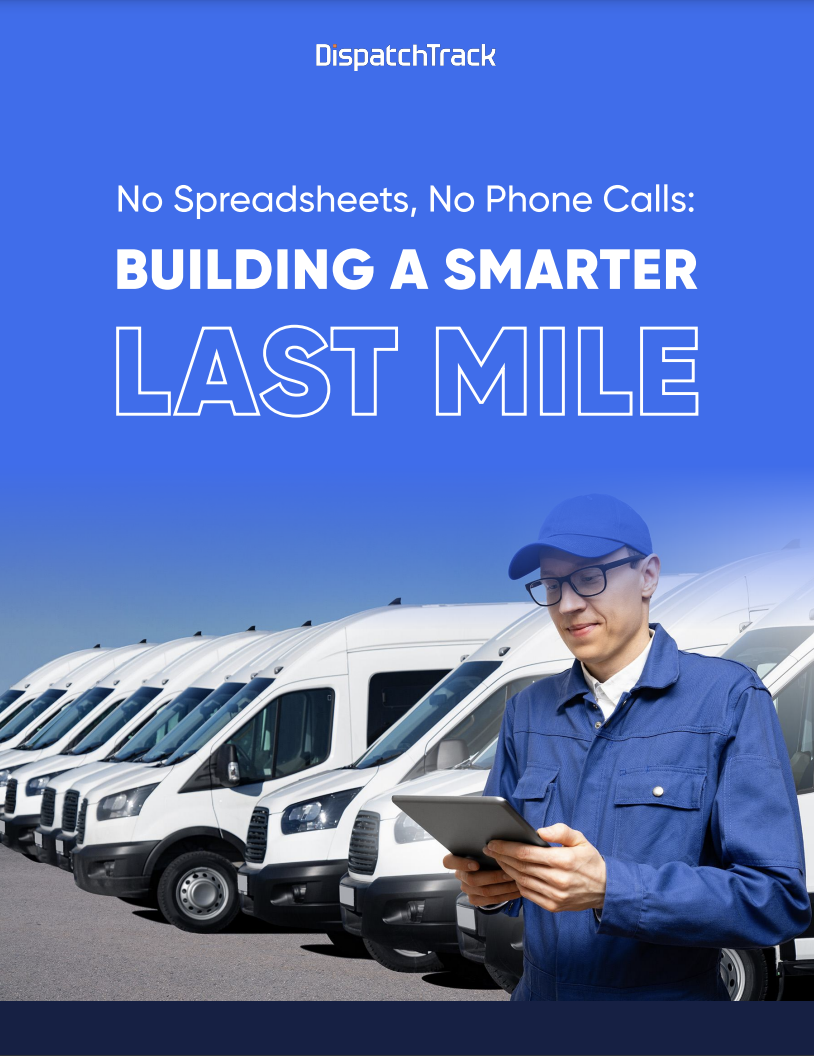WHITE PAPER
No Spreadsheets, No Phone Calls: Building a Smarter Last Mile
Last mile deliveries are at a turning point. If you’re still relying on spreadsheets or phone calls in your last mile delivery process, this is your official invitation to upgrade—and a guide to saving money and delighting customers by replacing those outdated processes.
Once upon a time, to really take control of your supply chain processes you basically had to become a technology company. You’d need to put together and maintain a complex technology stack with a lot of moving parts, and you’d need a team to maintain it. Every few years you would need to replace your on-site servers, and in the meantime you would have to expend significant resources making sure your software was up-to-date and running on a scale that worked with the needs of your evolving logistics needs.
This can work for larger businesses with budgets to wield on IT staff and even some developer talent. But for smaller companies the barriers to entry have historically made it hard to roll out big technology projects effectively.
With the advent of cloud technology, this is shifting—fast.
Now, logistics operations as small as a handful of trucks can leverage the most sophisticated technology on the market across their entire supply chain. When it comes to the last mile, many (if not most) solutions charge by the truck or service unit, which makes it possible to easily grow your usage as needed.
What does this mean for delivery businesses like building supplies distributors, 3PLs, furniture and appliance retailers, food distributors, and businesses that grapple with the last mile? It means that “that’s the way it’s always been done” is no longer a good enough reason to stick with the status quo.
When it comes to optimizing routes, there’s no longer any real excuse to do it by hand—or even with a legacy solution that doesn’t offer the most advanced capabilities. The tools that distributors need to deliver on time consistently without spending hours putting their routes together are out there.
Likewise, when it comes to staying connected and providing visibility, there are better and better alternatives to phone calls. Simply put, calling customers individually to let them know when to expect their deliveries doesn’t scale—and neither does calling drivers to find out their statuses. That’s the reason that many delivery operations have historically had to run entire call centers just to keep their customers informed.
Things like visibility, connectivity, and agility aren’t just theoretical when it comes to making your last mile deliveries more cost-efficient and predictable.
Why It’s Time to Ditch the Spreadsheets (and How to Do It)
Let’s picture a scenario. It’s Sunday afternoon, and you’ve got a few dozen customers all expecting their pallets of lumber and other building supplies tomorrow. A few need AM or PM deliveries. A few others have deliveries that require specialized equipment. And one or two need some kind of installation or service, which means that you have to make sure that they wind up on routes with skilled drivers/technicians.
You have a Microsoft Excel spreadsheet pulled open on your laptop. In it, you’re tracking:
– Which trucks are available when, and what their relative capacities are
– Which drivers are available which days and during which hours
– What quantities each customer ordered and what their preferred time slots are (if applicable)
– Customer addresses and the zones they correspond within your network
– Which warehouses or distribution centers have which SKUs and in what quantities
There’s a lot more that’s going to go in there—and there’s a lot of critical information that’s probably not going in the spreadsheet at all.
Which specialized trucks go with which types of jobs is probably something that only exists in your head if you’re the route planner. Same thing if there’s any sort of driver affinity for recurring clients, to say nothing of which zones have leeway and for which locations, how much time different kinds of jobs will take on site, which drivers are the fastest and slowest, etc.
It’s a logic puzzle that would make an LSAT-taker blush. You’ll need to cross-reference stops against where they are on the map and make your best guess as to how long the teams will need to spend on site.
You can add in extra buffer time to be safe if you’re not sure, but the risk there is that you’ll underutilize your capacity. Some customers may not get their orders as quickly as they’d hoped—which can be bad for customer loyalty—and you’re getting paid for fewer deliveries while potentially paying your drivers the same amount.
In spite of all these obstacles, many hours later, you’ve got the day’s routes figured out. You’re ready to provide route assignments and manifests to drivers, when a last-minute order comes in. You’ve achieved some semblance of efficiency so far, but by trying to shoehorn in one more stop there’s a risk that you lose out that efficiency and your cost-per-delivery increases noticeably.
The next day, you do it all again with a completely new set of orders.
Why the Status Quo Is Untenable
Optimizing delivery routes this way can be done—it’s what plenty of businesses have done for years. But it’s a recipe for high costs and slow routes.
The hours that you or your routers spend putting routes together are costly.
– Driver pay and fuel are proportionally more expensive when you’re not leveraging optimal routes (i.e. the routes with the shortest distance and/or the least time)
– The lack of flexibility caused by slow planning can come with a number of hidden costs, from poor capacity utilization to customer churn.
To compete in the current delivery market, businesses need to be fast, flexible, and connected. They need to be able to meet customer needs in a way that bolsters their bottom line. That means ditching the spreadsheets and leveraging smarter processes and technology.
Download now to read on!
